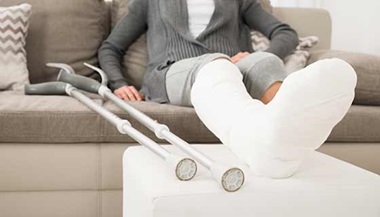Ulna and Radius Fractures (Forearm Fractures)
Ulna and Radius Fractures: What You Need to Know
-
The forearm is made up of two bones, the ulna and the radius.
-
A forearm fracture can occur in one or both of the forearm bones.
-
Some of the causes include falls on the forearm or outstretched arm and direct impact from an object to the forearm.
-
Treatment for forearm fractures is almost always operative, but nonoperative management can be used in specific cases — usually for an isolated ulna fracture.
What is a forearm fracture?
The forearm consists of two bones, the radius and the ulna, with the ulna is located on the pinky side and the radius on your thumb side.
Fractures of the forearm can occur at different levels: near the wrist at the farthest (distal) end of the bone, in the middle of the forearm or near the elbow at the top (proximal) end of the bone. They can occur through a direct blow (a fall on the forearm or direct impact from an o bject) or indirect injury. The latter is usually secondary to landing on an outstretched arm.
What are the different types of forearm fractures?
Forearm fractures can occur as a single (radius or ulna only) or combined (both bones) fracture.
When both bones are fractured at different levels and there is a joint injury at the wrist or elbow, these are described as Galeazzi or Monteggia fractures:
-
Galeazzi facture: Most often a displaced fracture in the radius and a dislocation of the ulna at the wrist, where the radius and ulna come together.
-
Monteggia fracture: Most often a fracture in the ulna and the top (head) of the radius is dislocated at the elbow joint.
What is the treatment for a forearm fracture?
Nonoperative Treatments
A stable, simple and isolated fracture of the ulna (secondary to a direct blow) can be treated with a cast for about four to six weeks. Your doctor will closely follow your progress with X-rays to assure nondisplacement of the fracture and proper bone healing. During this time, weight lifting and bearing is not permitted.
After removal of the cast, you will start physical therapy with specific exercises to regain full range of motion of your elbow and wrist and rotation of the forearm. Your doctor will increasingly allow you to lift weights according to how your fracture is healing.
Surgical Treatments
Surgery is performed in most of the forearm cases and usually performed through one or two incisions at different levels and sides of the forearm. The fractures are reduced and held together with plates and screws. After surgery your forearm will be put in a short splint for comfort and protection. You will not be allowed to lift weight for six weeks after surgery.


.png?h=170&iar=0&w=200&hash=59CEE2D9B28155C77CEEC18D1582DAE4)

.png?h=170&iar=0&mh=260&mw=380&w=200&hash=A5411087D582A22AA77E2C122660E28D)

